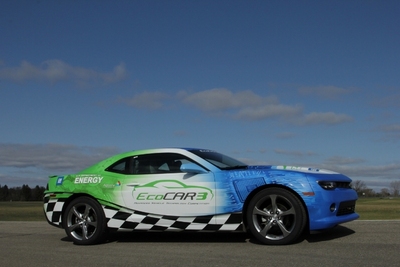EcoCAR 3 Announces Student-designed Powertrain Plans for Chevrolet Camaro
 EcoCAR 3, the latest U.S. Department of Energy Advanced Vehicle Technology Competition sponsored by General Motors, announced the powertrain and fuel |
CHICAGO -- November 18, 2015: EcoCAR 3's 16 competing university teams have unveiled their advanced, energy-efficient vehicle architecture for the 2016 Chevrolet Camaros donated by General Motors.
"Our teams were tasked with designing a powertrain configuration that reduces energy consumption, as well as well-to-wheel greenhouse gas and tailpipe emissions," said Kristen De La Rosa, EcoCAR 3 program director at Argonne National Laboratory. "Each team must also consider cost and innovation while maintaining the vehicle's ability to meet consumer demand in areas of performance, utility and safety."
EcoCAR 3 gives students the unique opportunity to gain hands-on experience following a real-world vehicle development process to solve complex engineering challenges. Participants gain access to millions of dollars of cutting-edge software tools and components and top industry subject matter experts that enable them to develop innovations and technologies that will push the industry forward.
In the first year, teams spent considerable time researching psychographic, demographic and socioeconomic data to better understand the needs and expectations of their regional consumer base. Using this insight, each team submitted its top three architecture design (powertrain and fuel) choices to EcoCAR 3 organizers who then pool resources to secure hardware, software and mentors needed to help the students achieve their goals of designing and marketing the ultimate energy-efficient, high-performance Camaro.
The teams explored a wide variety of powertrain configurations ranging from pure electric vehicles to a traditional hybrid. Teams also had the option of choosing from different fuel options, including:
- E10 – a low-level blend composed of 10 percent ethanol and 90 percent gasoline;
- E85 – a renewable fuel made from plant material that is a gasoline-ethanol blend containing 51 to 83 percent ethanol; and,
- B20 – a common biodiesel bend with 20 percent biodiesel and 80 percent petroleum diesel.
"Although the EcoCAR 3 Camaros will remain prototypes, this exercise in selecting a target audience and designing a vehicle's architecture introduces our teams to the realities of the real-world product development process," said De La Rosa
Almost all the teams had similar plans for creating the green Camaro of the future – a plug-in hybrid electric vehicle (PHEV) powered by E85. A PHEV has an internal combustion engine, one or more motors and is recharged using the electrical grid. Typically, PHEVs use electricity first and once the battery is depleted, the engine turns on and the fuel is used operating like a traditional hybrid vehicle.
The team to buck the trend, The University of Tennessee, Knoxville, will pursue a hybrid electric vehicle powered by E10.
The participating schools and the vehicle architecture they will perfect during the next three years, include:
- University of Alabama – Series-Parallel Plug-In Hybrid Electric Vehicle powered by E85
- Arizona State University – Parallel Plug-In Hybrid Electric Vehicle powered by E85
- California State University, Los Angeles – Parallel Plug-In Hybrid Electric Vehicle powered by E85
- Colorado State University – Parallel Plug-In Hybrid Electric Vehicle powered by E85
- Embry-Riddle Aeronautical University – Series-Parallel Plug-In Hybrid Electric Vehicle powered by E85
- Georgia Institute of Technology – Parallel Plug-In Hybrid Electric Vehicle powered by E85
- McMaster University – Series-Parallel Plug-In Hybrid Electric Vehicle powered by E85
- Mississippi State University – Series-Parallel Plug-In Hybrid Electric Vehicle powered by E85
- The Ohio State University – Series-Parallel Plug-In Hybrid Electric Vehicle powered by E85
- Pennsylvania State University – Parallel Plug-In Hybrid Electric Vehicle powered by E85
- University of Tennessee, Knoxville – Parallel Hybrid Electric Vehicle powered by E10
- Virginia Tech – Parallel Plug-In Hybrid Electric Vehicle powered by E85
- University of Washington – Series Plug-In Hybrid Electric Vehicle powered by E85
- University of Waterloo – Series-Parallel Plug-In Hybrid Electric Vehicle powered by E85
- Wayne State University – Parallel Plug-In Hybrid Electric Vehicle powered by E85
- West Virginia University – Parallel Plug-In Hybrid Electric Vehicle powered by E85
To learn more about the EcoCAR 3 program, please visit ecocar3.org.
EcoCAR 3 is a four-year collegiate engineering program that builds on the successful 26-year history of Department of Energy advanced vehicle technology competitions (AVTC) by giving engineering students the chance to design and build advanced vehicles that demonstrate leading-edge, eco-friendly automotive technologies. General Motors provides each of the 16 competing teams with a Chevrolet Camaro, as well as vehicle components, seed money, technical mentoring and operational support. The U.S. Department of Energy and its research and development facility, Argonne National Laboratory, provide competition management, team evaluation and logistical support. Through this important public/private partnership, EcoCAR 3 provides invaluable experience and training to promising young minds entering the North American job market. EcoCAR 3 follows the widely acclaimed competition series EcoCAR 2: Plugging In to the Future.


